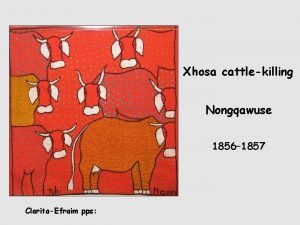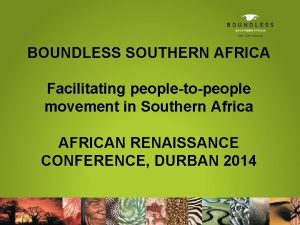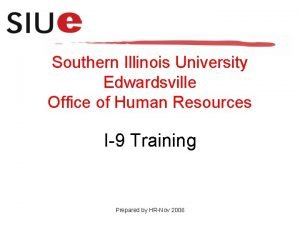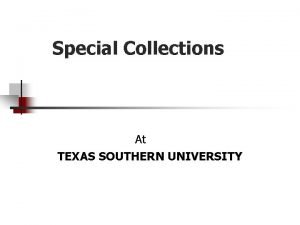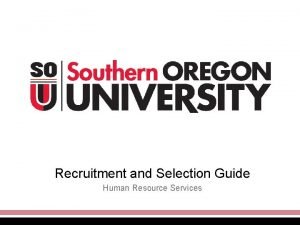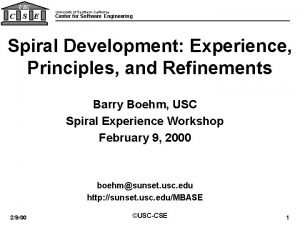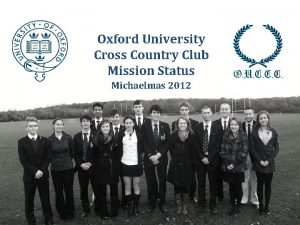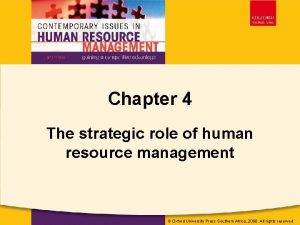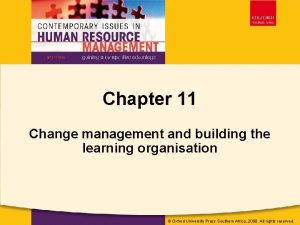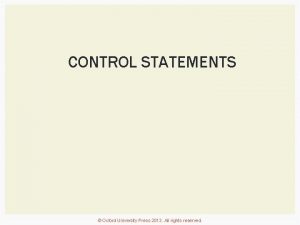Oxford University Press Southern Africa 2008 All rights





































- Slides: 37

© Oxford University Press Southern Africa, 2008. All rights reserved. Chapter 3 Human resources and leadership © Oxford University Press Southern Africa, 2008. All rights reserved.

© Oxford University Press Southern Africa, 2008. All rights reserved. Learning outcomes After reading this chapter you should be able to: • define the concept of leadership • discuss the ten leadership management roles • explain the difference between successful and unsuccessful leadership • identify several individual models of leadership • identify several group models of leadership • identify several organisational models of leadership • list the different leadership training/development techniques • describe the leadership role of human resources

© Oxford University Press Southern Africa, 2008. All rights reserved. Chapter Content • opening case: Sam Magubane - Sun Sporting Goods • introduction • the concept of leadership • what leaders do in organisations • the three levels of leadership (individual, group and organisational) • successful and unsuccessful leadership • leadership training and development techniques • leadership role of human resources

© Oxford University Press Southern Africa, 2008. All rights reserved. What is ‘leadership’? • activity of influencing people to strive willingly for group objectives • process of influencing the activities of individual/group in efforts towards goal achievement in a given situation • process of giving purpose (meaningful direction) to collective effort, and causing willing effort to be expended to achieve such a purpose • getting people to move in directions, make decisions and support paths they would not typically have selected • process of making sense of what people are doing together, so they will understand be committed • process of articulating visions, embodying values and creating the environment within which things can be accomplished

© Oxford University Press Southern Africa, 2008. All rights reserved. Important aspects from the definition • leadership is a process and not a position • involves a relationship between a leader and followers in a given situation • involves influencing people - leaders gain the commitment and enthusiasm of followers who are willing to be influenced • influences followers to think not only of their own interest, but the interest of the organisation • involves influencing followers to bring about change towards a desired future for the organisation • complex phenomenon involving: – leader – follower – situation

Complementarity of ‘leadership’ and ‘management’

© Oxford University Press Southern Africa, 2008. All rights reserved. What leaders do on the job? • called leadership managerial roles • Mintzberg, ten managerial roles that leaders perform to accomplish organisational objectives, grouped into three categories: – interpersonal roles – informational roles – decision roles

© Oxford University Press Southern Africa, 2008. All rights reserved. Models of leadership • three main streams – individual models of leadership – group models of leadership – organisational models of leadership

© Oxford University Press Southern Africa, 2008. All rights reserved. Individual models of leadership • three main streams – individual models of leadership (traits-based, behavioural-based, situational-based) – group models of leadership (cross-functional teams, SMWT, executive teams) – organisational models of leadership (transactional-based, transformational-based, charismatic-based, managerial based, strategicbased, institutionalised leadership, eleadership)

Leadership traits

© Oxford University Press Southern Africa, 2008. All rights reserved. Behavioural-based approach • popular in the 1950’s • leadership styles that would be effective across all situations • most studies used questionnaires measuring taskorientated and relations-orientated behaviour • studies were conducted to see how these behaviours correlated with criteria of leadership effectiveness such as subordinate satisfaction and performance • results from the massive research efforts have been mostly contradictory and inconclusive • two leading research projects that are associated with this theory are the Ohio State project and the University of Michigan research

© Oxford University Press Southern Africa, 2008. All rights reserved. Situational-based approach • 1960’s and 1970’s • expanded on the trait theory (includes tasks to be completed, the factors affecting the situation both leader and followers are in and the personality traits of the followers) • also referred to as the contingency theory • useful way to get leaders to think about how leadership effectiveness may depend somewhat on being flexible with different subordinates - not acting the same way towards them all • popularised by Hersey & Blanchard, Fiedler, Vroom & Yetton

© Oxford University Press Southern Africa, 2008. All rights reserved. Cross-functional teams • improving coordination of the independent activities among specialised sub-units • this type of team usually includes employees from each of the functional sub-units • these teams allow flexible, efficient deployment of personnel and resources to solve problems as they occur • are normally creative in generating different ideas and also in providing interesting solutions to various problems • negative aspects (it is not always possible to get the members to participate sufficiently, time-consuming meetings may result, and there is the possibility of role conflicts as a result of the competing demands of team members)

© Oxford University Press Southern Africa, 2008. All rights reserved. Cross-functional teams • four leadership functions can be identified that appear to be essential for cross-functional teams that solve problems, manage projects or develop policy. These are: – envisioning - articulating strategic objectives or a vision and encouraging the team to consider innovative performance strategies – organising - planning and scheduling team activities – social integration - encouraging mutual trust and open communication among team members – external spanning - monitoring the external environment to identify client needs and emerging problems, and promoting a favourable image of the team to outsiders

© Oxford University Press Southern Africa, 2008. All rights reserved. Self-managed work teams (SMWT) • responsibility and authority for making important management decisions is turned over to self-managed teams • teams are responsible for producing a distinct product or service • parent organisation usually determines the mission, scope of operations and budget, self-managed teams are responsible for setting their own performance goals and quality standards • internal leadership role of these teams involves management responsibilities assigned to the team and shared by the group members • typical to have an internal team leader who is responsible for coordinating the team activities

© Oxford University Press Southern Africa, 2008. All rights reserved. Self-managed work teams (SMWT) • not unknown to rotate this position among several team members • shared leadership in self-managed teams can take many different forms besides the rotation of the team leader position • some supervisory functions may also be performed collectively by members and some administrative responsibilities distributed to individual members

© Oxford University Press Southern Africa, 2008. All rights reserved. Executive teams • CEO shares power with the top management team • advantage is that team members can compensate for weaknesses in the skills of the CEO • thus, leadership is becoming a ‘team sport’ - a set of executives now takes on the responsibility for providing leadership to the whole organisation • advantages include the generation of more ideas, increased ownership of products, increased commitment and motivation, a wide range of views and perspectives, sharing of risks, transfer of expertise and social support

© Oxford University Press Southern Africa, 2008. All rights reserved. Executive teams • quality of team performance at the executive level is critical • model designed by Carlos Rivero - elements of executive team effectiveness • model used to diagnose threats to the team's effectiveness and indicates the team's opportunities • elements of the model are linked with one another • another link is that between core processes and performance • for the executive team to lead the organisation successfully it must perform at least four leadership activities successfully (Nadler & Spencer): – (1) governance, (2) developing strategy, (3) leading strategic change teams (SCTs) and (4) creating a highperformance operating environment

© Oxford University Press Southern Africa, 2008. All rights reserved. Executive teams • Designing effective strategic change teams involves four important steps: (1) establishing the team charter (2) selecting team members (3) agreeing on key work processes (4) embedding a quality assurance process the work of the team into

© Oxford University Press Southern Africa, 2008. All rights reserved. Transactional-based approach • leaders are characterised by contingent-reward and management-by-exception styles of leadership • exchanges or agreements with followers are developed which point out what the followers will receive if they do something right (or wrong) • lasts only as long as the needs of both leader and follower are satisfied by the continuing exchange process • not a relationship that binds the leader and follower together in a mutual and continuing pursuit of higher purpose • thus, in a sense one can say that a purely transactional style of leadership may be counter-productive

© Oxford University Press Southern Africa, 2008. All rights reserved. Transformational-based approach • raises both leaders and followers to higher levels of motivation and morality with a view to changing the present situation by focusing primarily on the external environment • consists of four behavioural components: – charisma = process through which leaders arouse strong emotions in followers – inspiration = leader behaviours such as articulating an appealing vision – intellectual stimulation = encourages followers to be creative in solving problems – individual consideration = includes leader behaviours that provide special support to followers (e. g. expressing appreciation for a job well done)

© Oxford University Press Southern Africa, 2008. All rights reserved. Charismatic-based approach • seeks to keep followers weak and dependent and to instil personal loyalty rather than a commitment to ideals • especially true in non-business organisations such as religious or political movements • existence within a business organisation is normally rare, as it will occur only when there is a collapse of formal authority to deal with a severe crisis

© Oxford University Press Southern Africa, 2008. All rights reserved. Managerial-based approach • combination of both transactional and transformational leadership • Flanagan & Thompson designed this model • pendulum was swinging back from the emphasis on transformational leadership • this swing could be the result of the exclusive emphasis on the creative component in the transformational leadership approach • a combination of both these leadership styles might be the answer • same leader can display both the transactional and transformational leadership behaviours in varying degrees and intensities, and also in a complementary way • third major component → situational sensitivity • enables management to diagnose the organisational situation and deploy appropriate leadership response - right combination of transformational and transactional leadership

© Oxford University Press Southern Africa, 2008. All rights reserved. Managerial-based approach • precise mix will vary from one organisation to the next and from one time to another • range of components from factors: – Transformational leadership skills create a vision, communicate meaning, inspire, empower, stir, take risks – Transactional management skills agree on objectives, communicate information, motivate, bargain, promote security, stabilise – Situational sensitivity scans organisation, reads jobs, understands self

© Oxford University Press Southern Africa, 2008. All rights reserved. Managerial-based approach • to be successful - need to have three components and exercise them holistically • components in the model build progressively on the others • vision and objectives must be communicated to the employees - will give meaning to their work • hard facts and information required to set further individual objectives against which to measure performance • if employees see meaning in what they do - can inspire them to greater efforts • process should be accompanied by the empowerment of employees • devolution of authority will enable employees to stir things up and be innovative

© Oxford University Press Southern Africa, 2008. All rights reserved. Strategic-based approach • Ireland & Hitt defined strategic leadership as “a person's ability to anticipate, envision, maintain flexibility, think strategically, and work with others to initiate changes that will create a viable future for the organisation” • will enable an organisation to achieve superior performance when competing in turbulent and unpredictable environments • CEOs who apply practices associated with 21 st-century strategic leadership can create sources of competitive advantage for their organisations - will have to cease viewing their leadership position as one with rank and title, but rather as a position of significant responsibility to a range of stakeholders • 20 th and 21 st centuries

© Oxford University Press Southern Africa, 2008. All rights reserved. Strategic-based approach • In this process, the CEOs will also have to satisfy the requirements associated with six key leadership practices, namely: – determining the company's purpose or vision – exploiting and maintaining core competencies – developing human intellectual capital – sustaining an effective organisational culture – emphasising ethical practices – establishing balanced organisational controls

© Oxford University Press Southern Africa, 2008. All rights reserved. Institutionalised leadership • closely related to the strategic based model • application of a special kind of leadership that appears to be critical during periods of discontinuous organisational change • Nadler et al identified four different types of change: – Tuning - initiate incremental change in anticipation of environmental events – Adaptation - as a result of external conditions and is reactive in nature – Reorientation - company initiates change as a result of an emerging environmental shift that is perceived (involves redefining the company's identity, vision and mission) – Recreation - sometimes caught unaware regarding certain changes that are taking place (must move quickly and change all the basic elements of the organisational system to survive)

© Oxford University Press Southern Africa, 2008. All rights reserved. Institutionalised leadership • reorientation type of organisation change, two types of leadership required: ü ‘heroic’ - excite employees, shape their aspirations and direct their • • • energy ü ‘instrumental’ - will make sure that individuals throughout the organisation behave in ways needed for the change to occur effective organisational change (reorientation change) requires both individuals may exist who can fulfil both roles - wise also to involve other employees in the leadership roles extend the leadership role beyond the individual leader and create institutionalised leadership extending the leadership to at least three groups - senior team, broader senior management group and throughout the entire organisation makes the challenge of leadership in the organisation more exciting

© Oxford University Press Southern Africa, 2008. All rights reserved. E-leadership approach • James G. Hunt • defined as “a social influence process mediated by advanced information systems to produce a change in attitudes, feelings, thinking, behaviour, and/or performance with individuals, groups and/or organisations” • can occur at any hierarchical level and involve both one-to one and one-to many interactions within and across large units and organisations • operates within the context of advanced information technology (AIT) • e-mail systems, message boards, groupware, group support systems, knowledge management systems, executive information systems • technologies can help leaders scan, plan, decide, disseminate and control information within the organisation

© Oxford University Press Southern Africa, 2008. All rights reserved. Leadership training/development techniques • effective selection process is a prerequisite to developing enduring leadership capability within the organisation • not enough that the managers with requisite skills are identified, they must also be given a chance to broaden and develop their skills through systematic job-related training and developmental experiences • little research on establishing how much learning from leadership development programmes has been transferred back into the workplace

© Oxford University Press Southern Africa, 2008. All rights reserved. Leadership training/development techniques • value of many existing programmes is questioned by authors – most of what has been done in leadership development falls drastically short – has been too rote, too backward looking and too theoretical – rarely been tied to a business's immediate needs – nor has it prepared leaders for the challenges of the future • the question: what should companies do in this regard? • first priority is the involvement and commitment of the CEO and senior executives of the company • by means of participating in the design of the programme, giving keynote talks and serving on discussion panels

© Oxford University Press Southern Africa, 2008. All rights reserved. Leadership training/development techniques • large variety of methods have been used for leadership training • interactive computer tutorials are used to learn technical skills • cases, exercises, business games, simulations and videotapes are used to learn conceptual and administrative skills • lectures, case discussions, role playing and group exercises are normally used to learn interpersonal skills • techniques for leadership development have also been identified

© Oxford University Press Southern Africa, 2008. All rights reserved. Leadership training/development techniques • ethics of leadership and leader’s degree of moral development are increasingly becoming essential elements of leadership research • survey of Fortune 1000 companies by the Saratoga Institute in Santa Clara, California

© Oxford University Press Southern Africa, 2008. All rights reserved. Leadership role of HR • as business partner, HR professional plays a crucial role in unlocking the organisation's people potential to help it achieve world-class status • will not be possible if it does not shed its control and bureaucratic role and act like a true leader • instead of orientating employees to their current roles, HR leaders must disorientate them so that they can take on new roles, new relationships, new values, new behaviours and new approaches to work • to be successful, activities such as creating an HR vision, developing an overall corporate HR strategy and instilling new values in employees are essential

© Oxford University Press Southern Africa, 2008. All rights reserved. Leadership role of HR • within the work context, developing and maintaining the technology infrastructure to support the organisation's HR programmes and establishing and managing proper communications to and from managers and employees are essential activities • these activities can all be seen as leadership activities when evaluating the content of this chapter • HR officers who play a leadership role are held accountable for the bottom line and are less controlorientated

Reorientating HR for its leadership role
 Oxford university press south africa
Oxford university press south africa Oxford university press answer
Oxford university press answer M.swan (oxford university press)
M.swan (oxford university press) Strlen(“oxford university press”) is
Strlen(“oxford university press”) is Oxford university press malaysia
Oxford university press malaysia Oxford university press
Oxford university press Oxford university press
Oxford university press 2008 2008
2008 2008 Nonqawuse
Nonqawuse Chapter 24 southern africa
Chapter 24 southern africa Volvo group southern africa
Volvo group southern africa Boundless southern africa
Boundless southern africa South african transport conference
South african transport conference Chartered secretaries southern africa
Chartered secretaries southern africa Southern africa
Southern africa Ketobe
Ketobe Cambridge university press 2011
Cambridge university press 2011 Vilnius university press
Vilnius university press Cambridge university press 2011
Cambridge university press 2011 Positive rights and negative rights
Positive rights and negative rights Littoral vs riparian
Littoral vs riparian Duty towards self
Duty towards self Legal rights and moral rights
Legal rights and moral rights Positive and negative rights
Positive and negative rights Positive vs negative rights
Positive vs negative rights Negative rights vs positive rights
Negative rights vs positive rights Negative right
Negative right Opposite rays
Opposite rays Southern federal university
Southern federal university Siue hr forms
Siue hr forms Texas southern university library
Texas southern university library Southern oregon university human resources
Southern oregon university human resources University of southern california
University of southern california University of southern california undergraduate
University of southern california undergraduate Southern connecticut state university public health
Southern connecticut state university public health Oxford university safety office
Oxford university safety office Webmail oxford
Webmail oxford Ouccc
Ouccc








